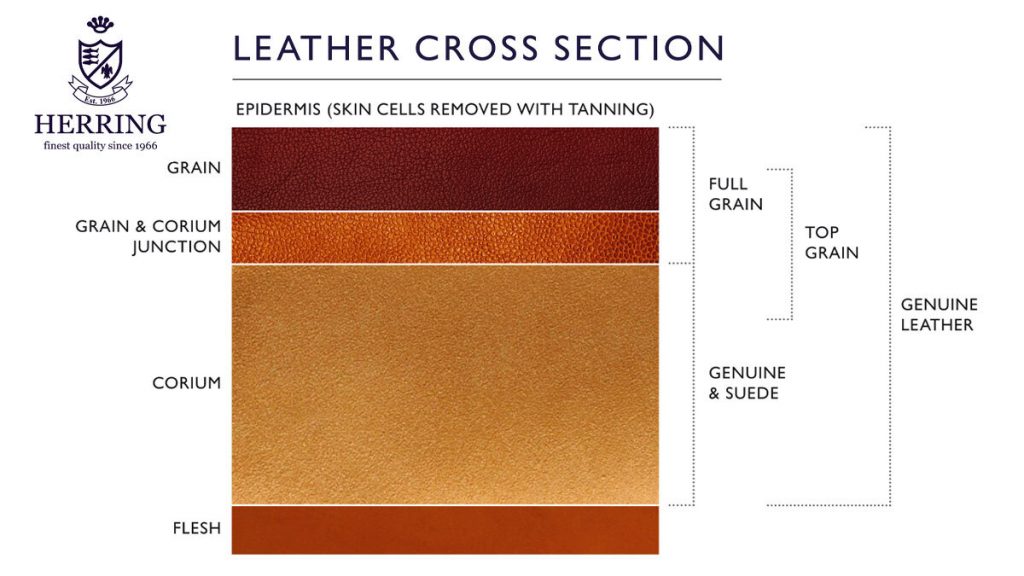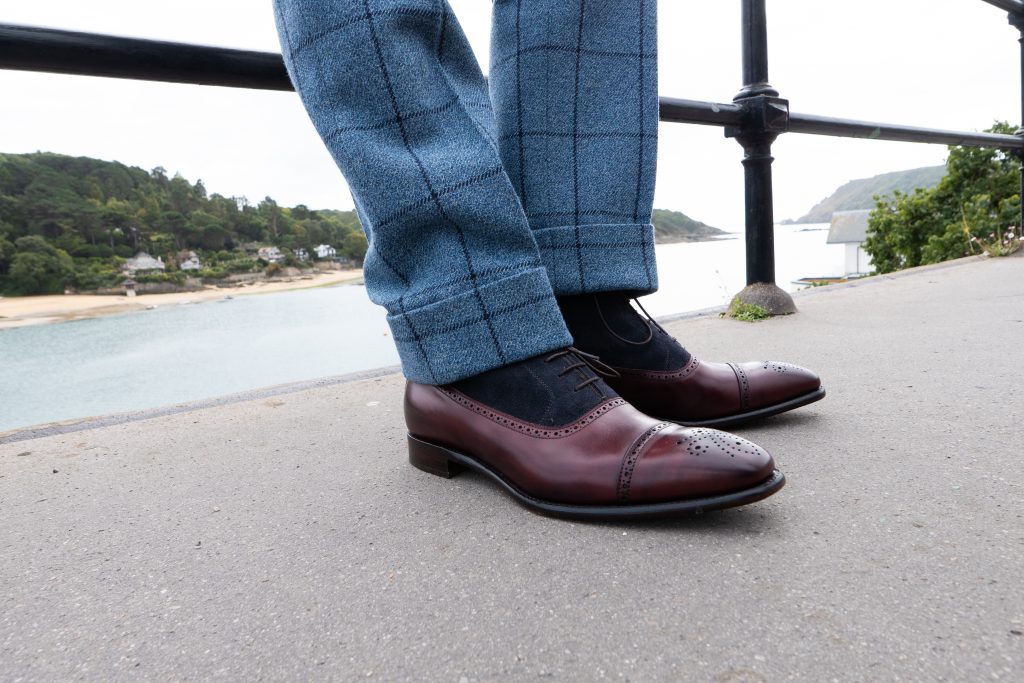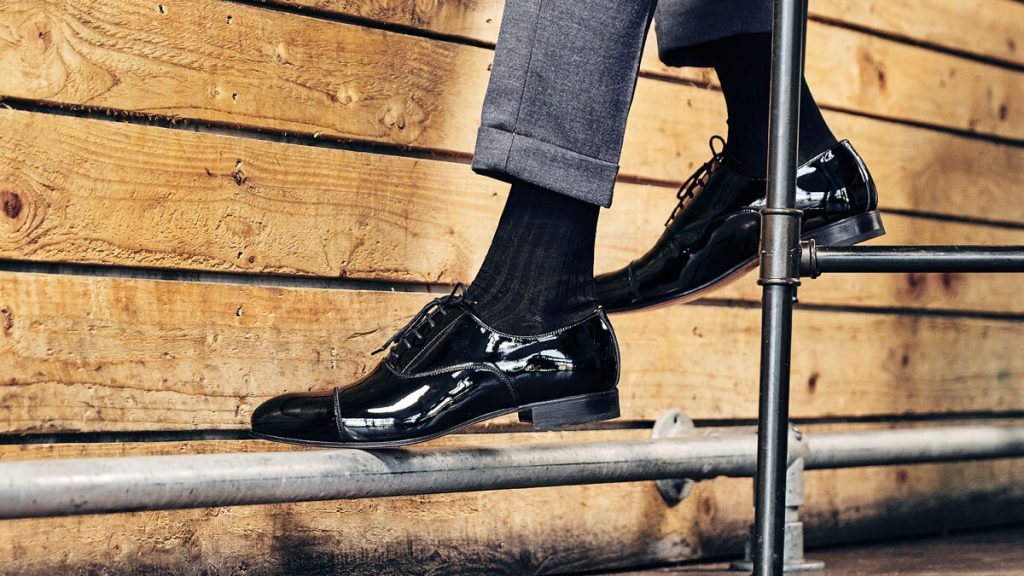Just as there are many different types of shoes and boots, there are multiple kinds of leather too. What you choose can completely change the look of your outfit. We have put together a brief guide on the types of footwear leather available, so you can make an informed choice. You can even filter our shoes on our website by type of leather to narrow your choice when browsing.
First though, you need to understand the difference between full-grain, top grain, and split leather:
- Full-grain leather is the entire top layer of dense, tightly packed fibres of a hide and the softer, more pliable, corium layer underneath.
- If you sand or buff the full-grain part of the hide from the top to get rid of any lumps and bumps, you would be left with the top grain. Full-grain is considered superior to top grain.
- Split grain is produced by splitting the full grain from corium layer. Both pieces of leather can be used for making shoes and both are considered genuine leather.

Leather types
Calf or calfskin
This is the most popular leather for shoes and boots. Most of our footwear is made from top grain calf as it has a lovely smooth finish, is very durable, and comes in different levels of suppleness to suit most styles of shoe or boot. It can be polished nicely to give a great shine and looks good for a long time.
Our classic Oxfords are a great example of a calf shoe, but so is our new Muswell Chelsea boot and so many others in our range. Calf really is a very versatile material to work with.
Polished leather
Polished leathers are treated to give a high shine appearance and are also often known as corrected leathers. The treatment they are given to make them shine can give an initial firmer feel to the shoe. Due to the extra covering given to the leather, small imperfections are covered up. This means that less expensive leather skins can be used so you will sometimes find that polished shoes are cheaper than a calf leather equivalent. A great example of a good quality polished style would be the popular Canning II Rubber soled brogues
Grain leather
Grain leather is usually a top grain calf leather with an embossed texture. It can be confusing that full grain leather isn’t often grain textured so you need to know that grain leather refers to the embossed pattern but full grain or top grain refers to the quality. The beauty of footwear made from grain (textured) leather is that it ages well as creases are easily hidden.
While grain leather lends itself to a more casual or rugged shoe or boot, it also works well for super smart footwear too. Perfect examples of the two is our Herald rubber-soled chukka boots compared to our Salamanca chukka boots. Same style of boot but a totally different vibe!
Please note that grain leather has several names due to the different patterns that the grain creates: country calf, fjord calf, hatchgrain, scotchgrain, sienna, Utah and willow are a few you may come across…and mock croc, of course.

Suede
A favourite with many of us at Herring due to its lovely but surprisingly durable texture. Suede is created by separating the underside of the skin or corium from the top grain. This makes it more delicate than a full-grain leather, but it’s no push-over! Looked after properly, suede can even be worn in inclement weather. You can even get what is known as roughout suede, which has a rougher (funny that) texture.
We think suede works well in the spring and is so versatile. For example, a suede loafer looks great with shorts, any brown suede shoe or boot brings out the best in blue jeans, while a blend of calf and suede can make your footwear really standout. Apply the suede filter on our website and have a peruse. On the first page of results alone, I am drawn to the James loafers, the Kirkby Chelsea boot and the new Jerry two-tone boots. For some rugged suede, check out the Coniston IIs; there’s nothing delicate about these bad boys!
Cordovan crup
This is beautiful horse hide leather, sometimes referred to as shell cordovan. The term ‘cordovan’ derives from the Spanish city of Córdoba and means ‘from Córdoba’. This leather is tanned carefully for a long period of time and hand-infused with natural oils to give the lustrous almost translucent look that is so prized, along with a long-life resilience that other leathers cannot match.
It is the best of best and is very sought after. It is super shiny and does not crease, but rather ripples instead, while also being durable and resistant to water. In short, cordovan crup looks beautiful. Our Barcelona II loafers are made from cordovan crup along with our Crawley brogues and Cromer boots.
Patent
Get those dancing shoes on and make way for patent leather! This is where leather has been treated to give it its high-gloss shine. It is a popular choice for wearing with black tie. As I say, patent just lends itself to dancing! Look no further than our Aston Oxfords. Beware of plastic alternatives that are prone to cracking.

Deerskin
Like goat and sheepskin, deerskin is rarely used for uppers of shoes and boots, as they are a bit more delicate. Consider how supple sheepskin slippers are and you will understand what I mean. We do use deerskin for our Noble slippers because they are super soft…even the sole is soft. We also have loafers made from deerskin too with a choice of leather or rubber sole depending on how much durability you require.
Best of the rest
Other leathers you may have heard of include nubuck, which feels like suede but is produced by sanding down the full- grain layer. Bison and buffalo has a very distinct natural grain, while kudu is also a grain but carries the beautiful marks and imperfections of this type of hide. Very strong and resilient, pigskin is often used to make footballs and gloves, but also works well for super-smart shoes. There are also several exotic leathers, but these are not seen so much these days due to strict regulations that ensure they have not been illegally sourced.
I hope you have enjoyed this whistle-stop tour of the types of leather used in shoemaking and understand why your choice of leather makes a real difference to the look and feel of your footwear.
No Comments